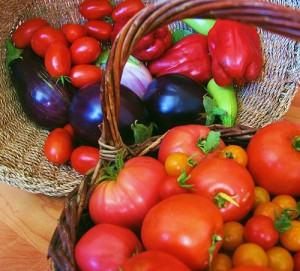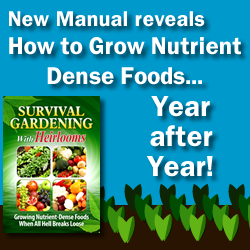 You’ve planted your garden, tended the seedlings, defended the plants from pests, and now you have a garden full of bounty. Now you need to learn how to harvest and store what you’ve grown. Each vegetable grows at its own rate and has its own harvest time. Let’s go through the basics of how to harvest and store common garden vegetables.
You’ve planted your garden, tended the seedlings, defended the plants from pests, and now you have a garden full of bounty. Now you need to learn how to harvest and store what you’ve grown. Each vegetable grows at its own rate and has its own harvest time. Let’s go through the basics of how to harvest and store common garden vegetables.
The best way to test for maturity is to taste test, but there are a few easy guidelines for judging when vegetables are ready for picking without eating all of them. Great flavor isn’t just a matter of color and size—it is the proper combination of soil, sun, and water that makes or breaks your garden’s performance. To assure the best flavor and texture, most vegetables are picked just prior to maturity.
Note: Some vegetables need to be harvested before first frost. Others may need freezing temperatures to complete the ripening process.
- Frost can occur at temperatures between 32-36 degrees Fahrenheit. A light freeze is temperatures between 28-31 degrees, a moderate freeze is between 24-28 degrees, and severe freeze is below 24 degrees.
- Some root crops may be left in the ground through winter, if covered with “heavy” mulch—one to two feet of hay or other organic material.
- Some vegetables need to be cured before winter storage. To do this, expose them to warm, dry air so that the skins harden and protect the cores from rotting.
Use the following guidelines set forth to judge if your garden is harvest-ready.
- Asparagus – Asparagus is best harvested young and tender. Cut when your spears are six to eight inches tall and about as big around as your pinkie. Some like to snap them off at ground level, but I like to use a stainless steel, straight-bladed knife. Cut on a diagonal, severing the stalks just below the soil level.
- Snap Beans – Pick beans before the seeds begin to bulge. They will easily snap in two when ready. Be sure to check on them daily, as it won’t take long for them to go from tender to tough.
- Broad or Lima Beans – Pick when pods are full but before they yellow. For tender limas, harvest slightly immature; for meaty beans, wait for full maturity.
- Beets – Greens can be harvested from beets you thin out of the rows. Harvesting the beets is truly a matter of size preference. You can begin when their shoulders protrude from soil line. Spring beets should be pulled before weather turns hot (late June to early July). Winter beets should be harvested before first moderate freeze.
- Broccoli – Broccoli is eaten before the flower buds open. Check the heads frequently, especially when weather begins to warm. This will ensure harvest before blooms open. Homegrown broccoli is smaller than store-bought varieties, so don’t look for yours to be large. Cut heads six to eight inches below flower buds. Side heads will come on after main head is removed.
- Brussel Sprouts – Sprouts mature from the bottom up. Begin harvesting when they are an inch or more in diameter. Remove them from the stalk by twisting off or cutting from stem.
- Cabbage – When heads feel solid to a gentle squeeze, cut from the stalk. Cabbage must be harvested at maturity, as it continues to grow and will split open.
- Carrots – These may be hard to judge. Carrot tops will begin to show at the soil line. This will allow you to judge when the diameter is right. Most likely if the diameter looks good, the length will be fine. Pull one to judge and harvest accordingly. Carrots may be left in the ground once mature, as it is said that a light frost sweetens flavor.
- Cantaloupe (Muskmelon) – The color should change to beige, and melons will slip from the vine when lifted.
- Cauliflower – Like broccoli, homegrown cauliflower won’t be as large as store-bought varieties. Cut from the stalk when the heads look full and the curds of the head are still smooth.
- Corn – About three weeks after silks appear they will turn brown and dull. Kernels should spill a milky substance when pricked.
- Cucumbers – These will race with zucchini to harvest. Check daily and pick while young and tender. Timing and size will be different according to variety. Cucumbers should be firm and smooth. If allowed to over-ripen, they can become pithy and bitter, even before turning yellow.
- Eggplant – Eggplant taste best if picked slightly immature. They should be firm, smooth, and shiny. Cut them, rather than pulling them from plants.

- Garlic – Tops will droop and start to brown when bulbs are ready to dig. Dig them; don’t pull out of the ground. Brush, rather than wash off the dirt, and allow bulbs to dry before storing. Braid the tops before they are dried out and then hang the garlic to dry the bulbs.
- Kale– Leaves can be gathered throughout the summer. Leaves should be deep green. Kale’s flavor is best in cool weather.
- Kohlrabi – The texture is best when bulbs are harvested at two to three inches in diameter. Bulbs become tough as they grow and age. Cut off at ground level.
- Leeks – Dig leeks when they are about an inch in diameter.
- Head Lettuce – Cut heads when they are full and firm when gently squeezed. Hot weather will cause lettuce to bolt or go to seed instead of filling out.
- Leaf Lettuce – Cut outer leaves when plants reach four to six inches high. Allow inner leaves to continue growing for later harvest. Leaf lettuce can be harvested like this most of the summer.
- Onions – Onions can be dug when tops fall over and begin to brown. Allow onions to dry in the sun or braid and hang to dry like garlic.
- Parsnips – Parsnips taste better when left in the ground until after a frost or two. They can also be allowed to “winter over” in the ground and dug in the spring. In cold areas, apply a heavy layer of mulch as directed above.
- Peas – Pods should look and feel full. Peas are sweeter when harvested before fully plumped and should be tasted to know if they are sweet enough.
- Potatoes – New potatoes can be dug when tops begin to flower. Carefully dig outer edges of the rows. Full-size potatoes should be dug when tops are dried out and brown. Dig from the outside perimeter, moving in cautiously to avoid cutting potatoes.
- Pumpkins –When pumpkins are the expected color and vines are declining, check the skin for cracking with a fingernail. If it doesn’t crack, it is ready. Picking too soon will halt coloring, so let them lay in the patch until just before first frost.
- Radishes – Radishes mature rapidly. When shoulders show above soil line, they are ready to dig. When left too long, they will toughen and then go to seed.
- Swiss Chard – See leaf lettuce above.
- Spinach – This green goes to seed quickly. Harvest by cutting at the soil line before flower stalks appear.
- Summer Squash – Pick young and check often. Skins should be tender, cutting with your fingernail.
- Winter Squash– Color is a good indicator of maturity. When it is the right color, cut squashes from the vine. Don’t expose to frost.
- Tomatoes – Harvest tomatoes when they are fully colored and slightly soft to the touch. Gently pull and twist from vine.
- Turnips – Shoulders should be two to two and a half inches in diameter at soil line when ripe. Harvest right away, as overripe turnips become woody.
- Watermelon – The spot on the flower end of the melon should change to a deep yellow when ripe. Some can hear a change in the sound made when thumped with a finger. It should sound hollow when ripe. (This skill needs to be developed, so don’t rely on it too much if you are a novice.)
Happy harvesting!
©2011 Off the Grid News
 Off The Grid News Better Ideas For Off The Grid Living
Off The Grid News Better Ideas For Off The Grid Living





